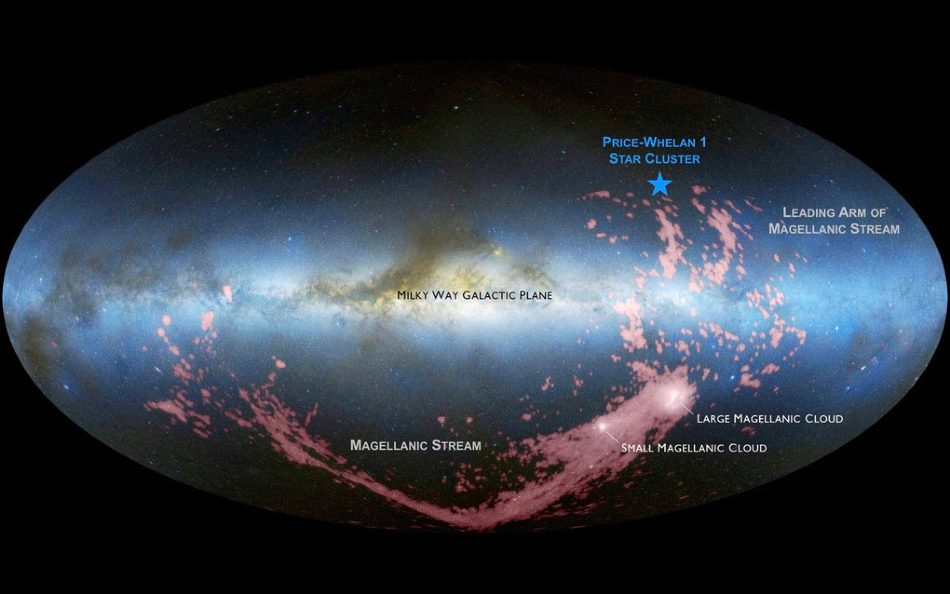Jan 8 2020
The oldest stars of the Milky Way galaxy are found within its outskirts. However, in this celestial retirement community, astronomers have observed something unpredicted—a cluster of young stars.
 Distant neighbors: A newfound cluster of young stars (blue star) sits on the periphery of the Milky Way. These stars probably formed from material originating from neighboring dwarf galaxies called the Magellanic Clouds. Image Credit: David Nidever; NASA.
Distant neighbors: A newfound cluster of young stars (blue star) sits on the periphery of the Milky Way. These stars probably formed from material originating from neighboring dwarf galaxies called the Magellanic Clouds. Image Credit: David Nidever; NASA.
A more surprising aspect indicated by the spectral analysis is that the origin of these infant stars is extragalactic. The stars do not appear to have formed from material in the Milky Way. By contrast, they are formed of material from two neighboring dwarf galaxies called the Magellanic Clouds.
These dwarf galaxies are on a course, colliding with the Milky Way. The finding indicates that a gas stream extending from the galaxies is nearly half as far from collapsing into the Milky Way as considered earlier.
This is a puny cluster of stars—less than a few thousand in total—but it has big implications beyond its local area of the Milky Way.
Adrian Price-Whelan, Research Fellow, Center for Computational Astrophysics, Flatiron Institute
Price-Whelan is the primary discoverer of the cluster, which has been named after him as Price-Whelan 1.
The newly discovered stars could offer a new understanding of the history of the Milky Way; for instance, they might reveal whether there was a collision between the Magellanic Clouds and the Milky Way in the past.
The study outcomes were presented by Price-Whelan and his team on January 8th, 2020, at the American Astronomical Society meeting in Honolulu. The discovery of Price-Whelan 1 was reported earlier in The Astrophysical Journal on December 5th, 2019, and the subsequent spectroscopic analysis of the stars was reported on December 16th, in the same journal.
It is highly difficult to identify clusters of stars since the Milky Way is packed with the radiant orbs. Although certain stars may seem to be close together in the sky, in reality, they are located at significantly different distances from Earth. Other stars that might neighbor one another briefly tend to move on in opposite directions. Over time, several accurate measurements will be required to identify which stars are actually clustered together.
Price-Whelan began with the most recent data gathered by the Gaia spacecraft that has measured and cataloged the motions and distances of 1.7 billion stars. He analyzed the Gaia dataset for stars that are blue and found clusters of stars moving alongside them. Such blue stars are very rare in the universe. Only one remained after cross-matching with and eliminating known clusters.
The newly discovered cluster is comparatively young (only 117 million years old) and located on the far outskirts of the Milky Way.
It’s really, really far away. It’s further than any known young stars in the Milky Way, which are typically in the disk. So right away, I was like, ‘Holy smokes, what is this?’
Adrian Price-Whelan, Research Fellow, Center for Computational Astrophysics, Flatiron Institute
The cluster is located close to a gas stream, called the Magellanic Stream, that makes up the outmost edge of the Small and Large Magellanic Clouds and heads toward the Milky Way. In contrast to gases in the outskirts of the Milky Way, gas in the stream does not contain large quantities of metal.
Led by David Nidever, assistant professor of physics at Montana State University in Bozeman, the metal content of the 27 brightest stars of the cluster was analyzed. Quite similar to the Magellanic Stream, the stars contain very little metal.
According to the researchers, the cluster formed when gas from the Magellanic Stream made their way through the gases around the Milky Way. This pass-through led to a drag force, which resulted in the Magellanic Stream gas being compressed.
Together with tidal forces from the gravitational tug of the Milky Way, this drag sufficiently condensed the gas to activate star formation. The stars raced ahead of the surrounding gas and joined the Milky Way over time.
The presence of the stars gives a special opportunity. It is highly challenging and imprecise to gauge the distance of gas from Earth. Therefore, astronomers were unsure of how far the Magellanic Stream was from colliding with the Milky Way.
However, the distance of stars is relatively trivial. The researchers used the movements and current positions of stars in the cluster to predict that the Magellanic Stream’s edge is located 90,000 light-years away from the Milky Way. That is approximately half the distance predicted earlier.
If the Magellanic Stream is closer, especially the leading arm closest to our galaxy, then it’s likely to be incorporated into the Milky Way sooner than the current model predicts. Eventually, that gas will turn into new stars in the Milky Way’s disk. Right now, our galaxy is using up gas faster than its being replenished. This extra gas coming in will help us replenish that reservoir and make sure that our galaxy continues to thrive and form new stars.
David Nidever, Assistant Professor of Physics, Montana State University
The updated distance to the Magellanic Stream will optimize models of the locations of the Magellanic Clouds and where they are moving, stated Price-Whelan. The optimized numbers could even offer a solution to the debate over whether the Magellanic Clouds have passed through the Milky Way earlier. A solution to the question, if found, will enable astronomers to gain better insights into the history and characteristics of the Milky Way galaxy.